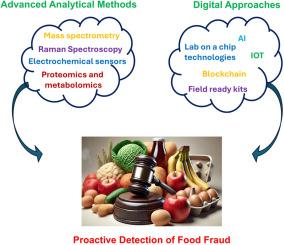Advanced analytical and digital approaches for proactive detection of food fraud as an emerging contaminant threat
IF 3.7
Q1 CHEMISTRY, ANALYTICAL
引用次数: 0
Abstract
The integrity of the global food supply is increasingly compromised by sophisticated fraudulent methods such as adulteration, mislabeling, and substitution. These deceptive practices introduce undisclosed and harmful substances that often evade traditional detection, posing significant risks to public health and consumer trust. This review synthesizes cutting-edge advancements in analytical and digital technologies that are redefining food fraud surveillance. We explore the convergence of molecular diagnostics (e.g., DNA barcoding, clustered regularly interspaced short palindromic repeats (CRISPR), next-generation sequencing (NGS)), high-throughput spectroscopic platforms (e.g., Raman spectroscopy, mass spectrometry), biosensors, and digital innovations (e.g., artificial intelligence (AI), Internet of Things (IoT), blockchain, and lab-on-a-chip (LOC) devices). These integrated approaches enable real-time, proactive detection of fraud across complex and globalized supply chains, offering sensitivity, scalability, and traceability previously unattainable. By framing food fraud as a form of emerging contamination, this work aligns with the paradigm shift toward predictive, data-driven risk assessment in contaminant detection. The review also addresses key translational bottlenecks such as cost, standardization, and interoperability, and proposes a systems-level roadmap to bridge scientific innovation with regulatory and industrial application. This interdisciplinary perspective advocates for a future where food authenticity assurance is intelligent, holistic, and resilient in the face of evolving adulteration threats.

先进的分析和数字方法,主动检测食品欺诈作为一种新兴的污染物威胁
全球食品供应的完整性日益受到掺假、贴错标签和替代等复杂欺诈手段的损害。这些欺骗性做法引入了未披露的有害物质,这些物质往往能逃避传统检测,对公众健康和消费者信任构成重大风险。本综述综合了分析和数字技术的前沿进展,这些技术正在重新定义食品欺诈监测。我们探索分子诊断(例如,DNA条形码,聚集定期间隔短回文重复序列(CRISPR),下一代测序(NGS)),高通量光谱平台(例如,拉曼光谱,质谱),生物传感器和数字创新(例如,人工智能(AI),物联网(IoT),区块链和芯片实验室(LOC)设备)的融合。这些集成的方法能够实时、主动地检测复杂和全球化供应链中的欺诈行为,提供以前无法实现的灵敏度、可扩展性和可追溯性。通过将食品欺诈视为一种新出现的污染形式,这项工作与污染物检测中向预测性、数据驱动的风险评估的范式转变保持一致。该综述还解决了关键的转化瓶颈,如成本、标准化和互操作性,并提出了一个系统级路线图,将科学创新与监管和工业应用联系起来。这种跨学科的观点提倡未来食品真实性保证是智能的,整体的,面对不断变化的掺假威胁的弹性。
本文章由计算机程序翻译,如有差异,请以英文原文为准。
求助全文
约1分钟内获得全文
求助全文

 求助内容:
求助内容: 应助结果提醒方式:
应助结果提醒方式:


